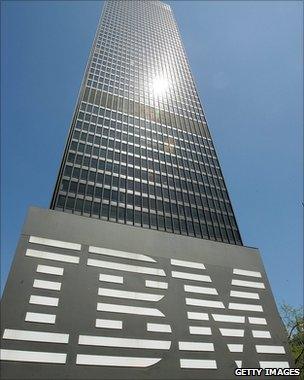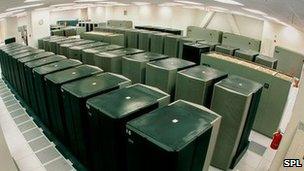IBM at 100: From typewriters to the cloud
- Published
WATCH: IBM, the firm that was once all about hardware, now makes its living from more intangible technology
Say IBM - and you probably still think of computers.
But today, the firm that was once all about hardware, makes its living from more intangible technology.
As it celebrates its centenary, International Business Machines is a business that shows how innovation has accelerated - and how fast you have to move to stay ahead.
The company they called Big Blue was the dominant force in early commercial computing, when mainframes arrived on a fleet of trucks and IT managers used to say "nobody ever got fired for buying IBM."
But those days are long gone.
"As a museum curator I come to a grinding halt in about 1992, because at that point it becomes more and more difficult to describe what IBM does," says Terry Muldoon, who worked as an engineer at the firm's UK research centre for more than 30 years and now runs a small museum documenting IBM's history.
First PC
It all started with the calculating machines, factory time clocks and meat scales, produced by the four companies that got together as International Business Machines in 1911.
Then came products that show IBM's record of innovation through the 1960s and 1970s: the disk drive, the floppy disk, the magnetic stripe that came to every credit card, and the barcode.
IBM prospered hugely when computing was restricted to giant corporations or public projects like the Nasa space programme.
The giant mainframes were built by IBM, with IBM microprocessors and IBM software.
But when computers got personal, life got tougher.
While it built the first PC in 1981, handing the operating system to Microsoft and the microprocessor to Intel proved a fateful decision.
"Wintel", not IBM, became the dominant force in home computing.
IBM continued to innovate, selling millions of computers to consumers for many years.
The museum at the Hursley research centre has the first portable computer, the IBM 5100, which must have given a sore back to anyone who tried to heave it onto their lap.
Software and services
But eventually in 2004 it got out of personal computers altogether, selling the business to China's Lenovo.
Terry Muldoon says throughout its history the company has moved on from technology, once profits have become harder to obtain: "IBM got out of the electric typewriter business because there was no more innovation to be done," he explains.

Today, IBM makes very sizeable profits from software and services
"All the time, a product is not a commodity, you can charge premium prices, the moment it is commoditised it is the Chinas of this world who take over manufacturing."
Today, IBM makes very sizeable profits from software and services.
Dr Andy Stanford-Clark, who rejoices in the title distinguished engineer and master inventor, represents the new face of the company.
We toured the Hursley research centre where around 1,500 staff work.
Years ago all sorts of groundbreaking computer hardware was developed on this site bought from Vickers Aviation, which had used it to build aircraft during the World War II.
Today, in an atmosphere more like a university campus than an industrial site, it is mainly a software development laboratory.
As we left Dr Stanford-Clark's office, the LED nameplate on his door changed to say he was out, reacting to a sensor in his mobile phone.
That was a colleague's research project, part of a wider exploration of ways of using sensors to share information between devices.
We saw various rooms set up to demonstrate the company's innovation to visiting customers - from a mock supermarket where prices on electronic paper could be changed by remote control, to a living room where household appliances could be controlled and energy use monitored from a mobile phone.
Cloud computing
But most of the hardware and even the software on display was not created by IBM.
The firm's scientists see their skills as meshing the best technology together to provide solutions to the problems their clients bring them.
"Twenty years ago IBM would create some technology it thought the marketplace needed, and then go and sell it to people," says Andy Stanford-Clark.
"Now we're customer-led, we're asked by our clients for what they want from us, and we're producing solutions rather than specific products to link together the complicated global infrastructure we find around us these days."
IBM is also making a big push into cloud computing, developing software to move big corporate clients into the cloud and building vast data centres to host them.
It is also looking at ways in which technology can make an impact in the healthcare sector, with sensors to monitor patients remotely.
But these are competitive sectors where IBM may struggle to achieve the kind of market dominance it once achieved in mainframe computers.
For all the changes in direction, the museum curator Terry Muldoon does see a continuing tradition of innovation.
He points to the strategy adopted by Tom Watson, the man who grew IBM from a ragtag collection of business machinery firms into a global giant: "When he became general manager in 1914, he realised there was a lot of good product but it wasn't applied," he explains.

At IBM, there seems to be a continuing tradition of innovation
"He put an enormous amount of money into research to improve the product and to show the customer some benefit from using the machines.
"That research and development ethos is still there, and it's still out there solving problems - and that's a 100 years later."
Surviving for another 100 years will mean adapting even more rapidly to a changing market.
And as technology becomes more intangible, finding ways to illustrate IBM's business in the museum at Hursley will get even harder.